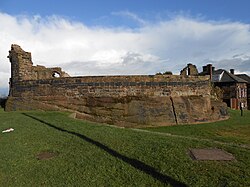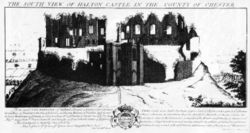| Halton Castle | |
|---|---|
 Part of Halton Castle ruins in 2006 | |
| Location | Halton, Runcorn, Cheshire, England |
| Coordinates | 53°19′59″N2°41′45″W / 53.3331°N 2.6957°W |
| OS grid reference | SJ 537,821 |
| Built | 11th century |
| Built for | Hugh d'Avranches, Earl of Chester |
| Architectural style(s) | Castle |
| Governing body | Halton Borough Council |
| Owner | Duchy of Lancaster |
| Website | nortonpriory |
Listed Building – Grade I | |
| Designated | 23 April 1970 |
| Reference no. | 1130460 |
| Designated | 26 November 1963 |
| Reference no. | 1015606 |
Halton Castle is a castle in the village of Halton, part of the town of Runcorn, Cheshire, England. The castle is on the top of Halton Hill, a sandstone prominence overlooking the village. The original building, a motte-and-bailey castle began in 1071, was replaced with the current sandstone castle in the 13th century. Building alterations continued until at least 1609, when the structure is recorded as in disrepair. The castle is recorded in the National Heritage List for England as a designated Grade I listed building, [1] and a scheduled monument. [2]
Contents
- History
- Early history
- Civil War
- Later history
- Present state
- See also
- References
- Citations
- Sources
- Further reading
It was the seat of the Barons of Halton from the 11th century until the 14th century, then passed to the Duchy of Lancaster. [3] It was besieged twice in the Civil War after which its structure deteriorated. In the 18th century a new courthouse was built on the site of the previous gatehouse. The castle lies in ruins apart from the courthouse which has been converted into a public house.


